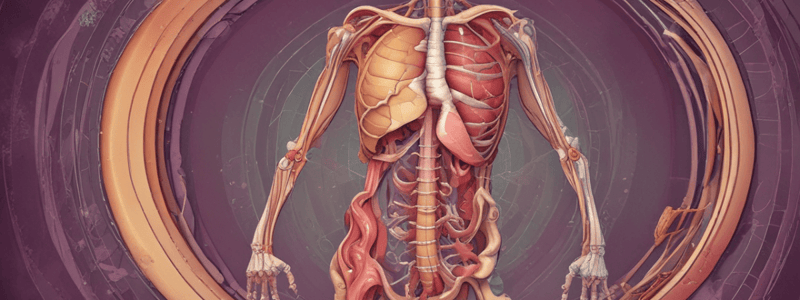Podcast
Questions and Answers
What is the primary cause of diverticular disease?
What is the primary cause of diverticular disease?
- High-fiber diet
- Smoking
- Regular exercise
- Low-fiber diet (correct)
What is the term for the presence of diverticula in the gut?
What is the term for the presence of diverticula in the gut?
- Diverticulum
- Diverticulosis (correct)
- Peritonitis
- Diverticulitis
What is the usual location of diverticula in the gut?
What is the usual location of diverticula in the gut?
- Rectum
- Small intestine
- Sigmoid colon (correct)
- Stomach
What is the risk factor associated with the development of diverticulosis?
What is the risk factor associated with the development of diverticulosis?
What is the complication that can occur if undigested food gets trapped in a diverticulum?
What is the complication that can occur if undigested food gets trapped in a diverticulum?
What is the term for the inflammation or infection of diverticula?
What is the term for the inflammation or infection of diverticula?
What is the reason for muscle weakness in the intestinal wall?
What is the reason for muscle weakness in the intestinal wall?
What is the prevalence of diverticulosis in adults over 80 years old?
What is the prevalence of diverticulosis in adults over 80 years old?
What is the association between NSAIDs and steroids and diverticulosis?
What is the association between NSAIDs and steroids and diverticulosis?
What is the typical symptom of diverticulosis?
What is the typical symptom of diverticulosis?
What is the term for the inflammation of diverticula in the colon?
What is the term for the inflammation of diverticula in the colon?
What is the typical location of abdominal pain in a patient with diverticulitis?
What is the typical location of abdominal pain in a patient with diverticulitis?
What is the primary goal of dietary management during an acute attack of diverticulitis?
What is the primary goal of dietary management during an acute attack of diverticulitis?
What is the recommended daily fiber intake for a patient with diverticulitis?
What is the recommended daily fiber intake for a patient with diverticulitis?
Which of the following foods is recommended for a patient with diverticulitis?
Which of the following foods is recommended for a patient with diverticulitis?
What is the purpose of a colonoscopy in a patient with diverticulitis?
What is the purpose of a colonoscopy in a patient with diverticulitis?
What is the primary reason for avoiding laxatives and enemas in a patient with diverticulitis?
What is the primary reason for avoiding laxatives and enemas in a patient with diverticulitis?
What is the term for the decrease in blood volume that can occur in a patient with diverticulitis?
What is the term for the decrease in blood volume that can occur in a patient with diverticulitis?
What is the purpose of checking for occult blood in the stool of a patient with diverticulitis?
What is the purpose of checking for occult blood in the stool of a patient with diverticulitis?
What is the recommended treatment for a patient with uncontrolled bleeding due to diverticulitis?
What is the recommended treatment for a patient with uncontrolled bleeding due to diverticulitis?
Match the following symptoms with their characteristics in diverticulitis:
Match the following symptoms with their characteristics in diverticulitis:
Match the following laboratory tests with their purposes in diverticulitis:
Match the following laboratory tests with their purposes in diverticulitis:
Match the following dietary recommendations with their purposes in diverticulitis:
Match the following dietary recommendations with their purposes in diverticulitis:
Match the following treatments with their purposes in diverticulitis:
Match the following treatments with their purposes in diverticulitis:
Match the following complications with their characteristics in diverticulitis:
Match the following complications with their characteristics in diverticulitis:
Match the following foods with their characteristics in diverticulitis:
Match the following foods with their characteristics in diverticulitis:
Match the following signs with their characteristics in diverticulitis:
Match the following signs with their characteristics in diverticulitis:
Match the following concepts with their characteristics in diverticulitis:
Match the following concepts with their characteristics in diverticulitis:
Match the following fluids with their characteristics in diverticulitis:
Match the following fluids with their characteristics in diverticulitis:
Match the following goals with their characteristics in diverticulitis:
Match the following goals with their characteristics in diverticulitis:
Match the following terms with their corresponding definitions:
Match the following terms with their corresponding definitions:
Match the following risk factors with their corresponding conditions:
Match the following risk factors with their corresponding conditions:
Match the following complications with their corresponding causes:
Match the following complications with their corresponding causes:
Match the following signs and symptoms with their corresponding conditions:
Match the following signs and symptoms with their corresponding conditions:
Match the following medications with their corresponding effects on the gut:
Match the following medications with their corresponding effects on the gut:
Match the following locations with their corresponding associations with diverticulosis:
Match the following locations with their corresponding associations with diverticulosis:
Match the following conditions with their corresponding relationships with diverticulosis:
Match the following conditions with their corresponding relationships with diverticulosis:
Match the following terms with their corresponding descriptions:
Match the following terms with their corresponding descriptions:
Match the following factors with their corresponding effects on diverticulosis:
Match the following factors with their corresponding effects on diverticulosis:
Match the following conditions with their corresponding age groups:
Match the following conditions with their corresponding age groups:
Flashcards are hidden until you start studying




